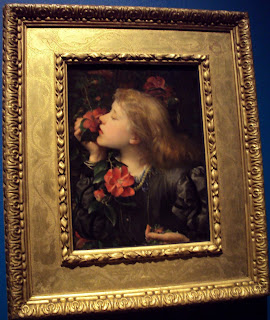 |
| Carmen with Horst, by Leonard McCombe, Life Magazine, 1947 |
So, you’re travelling in a bus in New York City. (Already, this is starting to seem like an impossible Christmas-season fantasy in this time of recession? Stay with me here.) Junior Bazaar magazine spots you and thinks that you may just be the cat’s pyjamas. That is, you have what it takes to be the next supermodel. Test shots are taken. They are sent to the magazine. You wait, and wait, and wait some more. The mission is a colossal failure. But hang on. You get an opportunity to shoot for Vogue, and suddenly, you are making $7.50 an hour to model for the world’s best-selling fashion magazine. Did I mention that you are thirteen years old? (Now you can’t tell if this is a dream to be enjoyed with a glass of mulled wine, or an Oliver Twist parody…)
The London College of Fashion presents a retrospective of Carmen Dell’Orefice, supermodel extraordinaire, a woman born in 1931 at the height of the Great Depression, on Welfare Island, New York. A woman who has invented and reinvented herself more times than Christmas turducken. This tiny, but exquisite, exhibition is a yummy hors d’oeuvre for the holidays, a glimpse of a sixty-six-year career of fashion’s favourite muse, not to mention the skill of the world’s best photographers that daily walk the line between fashion and art.
Magazine covers from Vogue and Harper’s Bazaar, advertisements for Elizabeth Arden and something called Hunt’s Catsup, portraits by Cecil Beaton and Horst P Horst feature in this exhibition that could easily be five times bigger and not put you to sleep.
In Irving Penn’s “Girl with Fruit, Shoe and Butterflies,” Vogue, 1946, Dell’Orefice sits surrounded by half a melon and a black leather pump. Butterflies flit around her, one sits on her shoulder, another on her shoe. And it is impossible to know if Dell’Orefice has just served tea and croquettes to the local chapter of the Women’s Institute, or butchered the latest in a long line of hapless victims in her basement.
Her Italian father was a violinist, her Hungarian mother, a dancer. Dell’Orefice was training to be a ballet dancer at the Swoboda School when she developed rheumatic fever. Her dance career may still have flourished if she hadn’t grown three inches in height during her illness. By the late 1940s, she was considered too underweight and anaemic to be glamorous. A visit to Condé Nast’s in-house doctor, however, pulled a miracle transformation out of the bag, and suddenly, Dell’Orefice glowed with health and vitality, not to mention an Amazonian bosom. This led, inevitably, to a flash career as a lingerie model at Vanity Fair and an asking price of $300 an hour.
Several decades, three husbands, and an honorary doctorate later, silver-haired Dell’Orefice laughs in your face in a series of photographs by Ali Mahdavi, recently commissioned by the London College of Fashion. As Norman Parkinson once said of the fashion camera’s favourite model, she “didn’t look bad for an old bag.”
Carmen: A Life in Fashion
London College of Fashion
Till January 28, 2012
Published in London Fringe Festival http://londonfestivalfringe.com/general/post/?p=14445 and The London Word http://www.thelondonword.com/2011/12/carmen-dellorefice-fashions-favourite-muse/































